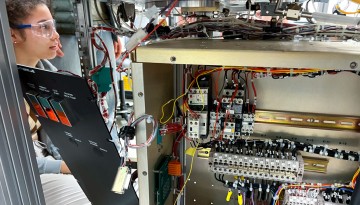High Schoolers Shown Their Engineering Future At Cornell University
A dozen people racing the clock are feverishly tearing apart a $65,000 plasma etcher inside Cornell’s Phillips Hall. One pulls out a vacuum chamber as her colleague scrambles through a stack of blueprints to find the matching part. The delicate machine, used to help fabricate integrated circuits, is in thousands of pieces with hardly any time left.
“This is pretty cool,” says Sarah Levine as she removes a gas valve. Time has run out and the team dismantling the large machine sets down the expensive hardware. The high-school students must get to their next activity.
New Visions Engineering is no ordinary program for high school seniors. For the past five years at Cornell, it has provided local students the opportunity to explore engineering careers and perform research activities typically experienced by college students – or in the case of disassembling a broken plasma etcher, not many people at all.
“We like taking things apart and seeing how it all works,” says Levine, a senior at Lansing High School, adding that the program has steered her academic interests toward civil and environmental engineering.
Students involved in the program – there are 13 participants this academic year – earn high-school credits, as well as seven college credits, by spending four hours a day, five days a week on Cornell’s campus. Students also visit dozens of field trip locations such as Lockheed Martin and other regional businesses, exposing students to industries important to New York state’s economy.
“We give them this wide variety of experiences, because a lot of them know they want to be engineers, but they don’t exactly know all the different types of engineering,” says David Syracuse, the New Visions Engineering teacher, who has appointments at Cornell Engineering and the Tompkins-Seneca-Tioga Board of Cooperative Educational Services, which both support the program. “It really gives the students a leg up on their counterparts because they have a more long-distance view of their trajectory as an engineer.”
Cameras, concrete and coffee
After gaining an appreciation for the inner workings of a plasma etcher, students will use a working version of the machine inside the clean room at the Cornell NanoScale Science and Technology Facility (CNF) to etch a logo onto a silicon wafer.
“This exercise is introducing students to many of the different career paths in nanotechnology, whether it’s building machines, operating them or designing microelectronics,” says Tom Pennell, CNF research support specialist and education coordinator. “And with the federal and New York state push for semiconductor development, programs like New Visions can create a pipeline of workforce talent.”
Other activities this academic year included building pinhole cameras and developing pictures in a photographic darkroom, reverse engineering the mechanics inside a rechargeable flashlight, using chemical engineering to brew coffee to a specific strength, and learning how concrete strength is tested in a structural engineering lab.
Cornell impacting New York State
“I wanted to do something different for my senior year and challenge myself,” says Taylor Brock from Candor High School, who added that his favorite activities involved food science experiments at Cornell AgriTech. “You know that feeling when you walk into a classroom and you don’t want to be there? I never feel that way with New Visions. Every day I get up and I’m like, ‘Let’s go do something.’”
New Visions’ focus on showing students how to apply science to solve societal problems provides a model for how STEM curricula could be better implemented in high schools, Syracuse says.
“These students understand engineering in a very intimate way, and that applying science is actually useful,” says Syracuse. “All of our past cohorts have gone on to do amazing things, and I think it’s due to the integrated nature of the program.”
After participating in New Visions in 2019, Emma Williamson decided to study industrial design at the Rochester Institute of Technology. She says the program prepared her for college in a way many of her peers were not.
“I have been motivated to explore, take as many classes in as many areas as possible, and to use all of the resources my university has available,” says Williamson, “things I would not know I could do if it weren’t for New Visions.”
The vast majority of New Visions Engineering students eventually choose to study a STEM field in college, Syracuse says. This year’s cohort is already learning to navigate higher education thanks to a newly implemented mentor initiative that pairs each student with a Cornell doctoral student who can offer guidance on the variety of STEM majors, degrees and financial aid options – advice that is especially valuable to students who will be first in their family to attend college.
And while college is still months away for this year’s New Visions cohort, Ben Anderson feels like he’s already there.
“This is as much of a college experience as I can get right now,” says Anderson, a Dryden High School senior, as he holds a turbo fan he removed from the plasma etcher. “I’m at one of the most prestigious universities in the world working on stuff at the nanoscale. That’s just awesome.”

